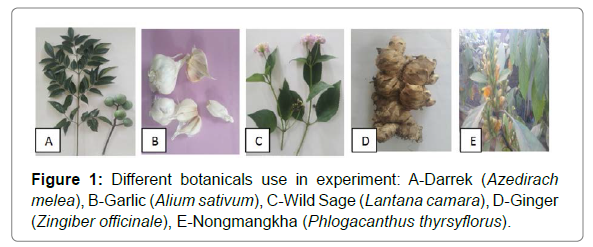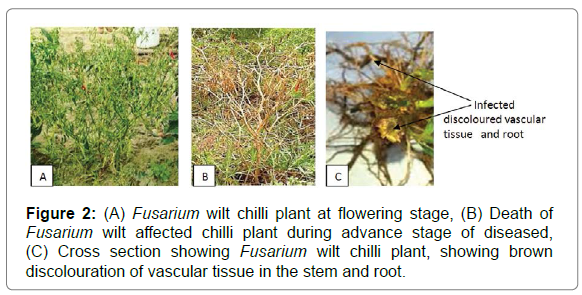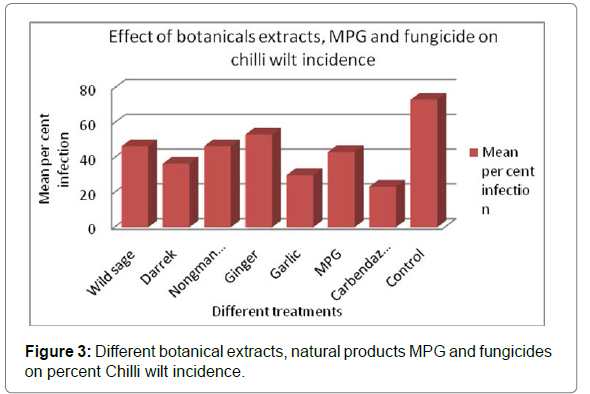Research Article, J Plant Physiol Pathol Vol: 9 Issue: 11
Effect of Botanical Extracts and MPG (Modified Panchagavya) on Chilli Wilt Incidence Caused by Fusarium oxysporum
David Kamei1, Archana U Singh2* and Gaichui Gangmei3
1KVK-Senapati, Manipur, ICAR, Delhi, India
2Department of Nematology, ICAR-IARI, New Delhi, India
3Department of Agriculture, Government of Manipur, India
- *Corresponding Author:
- Archana U Singh
Department of Nematology, ICARIARI, New Delhi, India
Tel: +91 8920719598
E-mail: arch_212@yahoo.com
Received Date: October 19, 2021; Accepted Date: November 05, 2021; Published Date: November 27, 2021
Citation: Kamei D, Singh AU, Gangmei G (2021) Effect of Botanical Extracts and MPG (Modified Panchagavya) on Chilli Wilt Incidence Caused by Fusarium oxysporum. J Plant Physiol Pathol 9:11. 273.
Copyright: © All articles published in Journal of Plant Physiology & Pathology are the property of SciTechnol, and is protected by copyright laws. Copyright © 2020, SciTechnol, All Rights Reserved.
Abstract
Chilli plants affected by wilt symptoms initially shows droopingand yellowing of lower leaves followed successively by youngerleaves at the time of flowering. Then upward and inward rollingof the leaves later, whole plant get wilted and dies within 30-40days. In the present investigation it was found that among thedifferent botanical extracts and natural product MPG (ModifiedPanchagavya) treatments lowest percent disease incidence wasrecorded in Garlic extracts (30%) followed by Darrek (36.66%),MPG (43.33%), Wild sage (46.66%) and Nongmangkha (46.66%)as compared to 73.33% in case of untreated control.
Keywords: Chilli Wilt; Fusarium oxysporum; Modified Panchagavya; Percent Disease Incidence
Introduction
Chilli is an important Spice crop known all over the world. InIndia Chilli rank first among all the spices with the share of 33.7% inthe total production [1]. India is the largest producer of Chilli in theworld accounting for over 45% of the total area under cultivation andthe largest exporter of Chilli exporting 2.5 to 3 percent of its produced.In Manipur north eastern state Chilli has been known since ancienttimes as one of the most important spice crops. It is widely grown asSummer crop in an area of 10140 hectares with total production of6080 tonnes [2]. Some of the popular Chilli species grown in the stateare Tree or King chilli (U-morok), Bird eye chilli, Black scented chilli,Meetei morok and the famous Sirarakhong chilli known as Hatheiwhich have been granted GI tag recently. The chill fruits owe itspungency and acidity due to the presence of pungent principle calledCapsaicin (Oleorescin capsicin). It is also rich in vitamin-C along witha small amount of vitamin-E and other food value.
Chilli is known to suffer from various diseases caused by fungi,bacteria, virus, nematodes which reduce the yield potential of thecrop. Among the fungal diseases affecting the Chilli crop, Wilt diseasecaused by Fusarium species is a serious one which results in total orpartial killing of the standing crops. The fungus invades the vascularsystem of the plant causing vascular discolouration after developingthrough root system to base of the stem. The symptoms appear as yellowing and wilting of foliage, first starting from the lower leaves and then woody tissue of the stem turns brown and later kill theplant. Sarhan and Sharif (1986) [3] worked on the incidence andseverity of pepper wilt caused by Fusarium oxysporum f. Sp. redolensand Fusarium wilt of Chilli caused by Fusarium annum L. They alsoreported that the disease was characterized by inward and upwardrolling of the leaves and wilting of the plant. The disease is soil borne.In Manipur Fusarium wilt disease of Chilli was most prominent andoccurs in severe forms. Since, most of the management practices are bythe use of chemical which is known for residue effect on environmentand humans. Therefore, the present work is taken up based on theuse of natural products like Modified Panchagavya (MPG) andindigenous botanical extracts in managing the chilli wilt disease.
Materials and Methods
Isolation and identification of pathogen
Chilli plants showing typical wilts symptoms was collectedfrom the farmers field and brought in the KVK-Senapati districtplant pathology laboratory for isolation. Isolation was made fromdiscoloured vascular tissues from collar and root region of an infectedplant by cutting into small pieces of 1 mm bits. These bits were surfacesterilized with 1% Sodium Hypo Chloride (NaOCl) solution for twominutes followed by three times serial washing in sterile water. Thesterilized bits were then placed aseptically on Potato Dextrose Agar(PDA) medium in sterilized plates and incubated at 27 ± 1°C for fivedays. Then the observations was taken for the development of thefungus and purified by single hyphal tip method (Figure 1).
Preparation of botanical extracts
The aqueous botanical extracts of five different indigenousplants grown in Manipur viz. Garlic bulb (Allium sativum), Gingerrhizome (Zingiber officinale), Wild sage leaves (Lantana camara),Darrek (Melia azedirach) and Nongmangkha leaves (Plogacanthusthyrsiflorus) was collected and washed with tap water followed bysterile water and dried in shade for 24 hours to remove the excessmoisture. The plant materials was weighed and crushed with the helpof a sterilized motar and pestle and made solution i.e., 1 g per 1 mlsterile water (1:1, w/v). The botanical extracts was filtered in doublelayer muslin cloth. Thus, this formed the standard 100% botanicalextracts solution required to be used in the experiment.
Preparation of Modified Panchagavya (MPG)
In Sanskrit Panchagavya mean a combination of five productsprocured from cow (Milk, curd, ghee, dung and urine). It is an ancientritualistic practice prescribed in Hindu scriptures to administer Panchagavya to human beings under many conditions of ill health,convalescence and as spiritual purifying agent [4].
In the case of our present investigation a Modified Panchagavya(MPG) was prepared following the method of Jahangirdar 2001 [5].For preparing 1 litre MPG slurry it require the following ingredientscow ghee-20 ml, curd-50 ml, milk-50 ml, cow urine-480 ml, cowdung-400 g, common salt-20 g and baking yeast-10 g. All theseingredients were thoroughly mixed and allowed to ferment for 10days with twice stirring daily. This crude fermented product wasdiluted 10 times with sterile water and this preparation is now takento be as 100 percent standard solution. The diluted preparation wasfiltered through two layers of muslin cloth and the filtrate was usedin the experiment at any desired level of concentration. The pH of themixture was recorded on zero day and at ten days of the incubationof the mixture (Figure 2).
In-vivo test
Effect of botanical extracts and modified Panchagavya (MPG) onthe wilt incidence of Chilli was carried out in pot experiment duringKharif, 2019-20 by using local susceptible Chilli cv. viz. Jiri collectedfrom the Department of Horticulture, Manipur and by followingthe methods of Haseeb 2005 [6]. Pot study was carried out in 15 cmtop diameter earthen pot filled with 1 kg sterilized sandy loam soil.Botanical extracts and MPG were tried at their best concentrationsi.e. Wild sage (5%), Darrek (15%), Nongmangkha (10%), Ginger(15%), Garlic (10%) and MPG (15%), and fungicides Carbendazim(0.1%) was used as check. Soils were drenched with each treatmentone week before transplanting the chilli seedlings. Twenty days oldseedlings of Chilli cv. Jiri was transplanted singly in each pot. Thefungus was multiplied on PDA medium under aseptic conditions in petriplates. When the medium was fully covered with fungal growth(seven days old), the growth was collected with the help of a sterilizedscalpel and washed with 100 ml of sterile water. The contents ofeach plate were filtered through muslin cloth to get suspension.The suspension was diluted to concentration of 4 × 108 spores/mlof sterile water. After three days of transplanting the prepared sporesuspension of Fusarium oxysporum were inoculated by pipetting 5 mlof spore suspension pouring around each seedling. The experimentwas carried out in Randomized Block Design (RBD) with threereplications of each treatment was taken. However, simultaneouslypots inoculated with F. oxysporum alone without any treatmentsserved as control. Soil drenching was repeated three times at 20 daysinterval. Plants were kept under observation and disease incidencewas recorded by counting the wilted plants at time of flowering andper cent infection was calculated by using the following formula:

Results and Discussion
The data presented in the above Table 1, is the results of the invivotest on the effect of botanical extracts and Modified Panchagavya(MPG) along with carbendazim (as check) on the Fusarium wiltincidence of Chilli cv. Jiri. Data revealed that among the differentindigenous botanical extracts and natural products (MPG), garlichas yielded the best results with minimum wilt incidence of 30.00%followed by darrek (36.66%), modified panchagavya (43.33%), wildsage (46.66%) and nongmangkha (46.66%) as compared to 73.33 percent in untreated control. However, Carbendazim used as check wasfound 23.33 per cent of wilt as compared to untreated control.
| S. No. | Treatments (T) | Concentration (C) | Mean percent infection* |
|---|---|---|---|
| 1. | Wild sage (Lantana camara) |
5% | 46.66 (6.86) |
| 2. | Darrek (Melia azedirach) |
15% | 36.66 (6.09) |
| 3. | Nongmangkha (Phlogacanthus thyrsiflorus) |
10% | 46.66 (6.86) |
| 4. | Ginger (Zingiber officinale) |
15% | 53.33 (7.33) |
| 5. | Garlic (Allium sativum) |
10% | 30.00 (5.51) |
| 6. | MPG (Modified Panchagavya) |
15% | 43.33 (6.61) |
| 7. | Carbendazim (0.1% as check) | 23.33 (4.87) | |
| 8. | Control | - | 73.33 (8.58) |
| SE ± d - 0.11, C.D - 0.23, *Observations taken at the time of flowering | |||
Table 1: Effect of botanical extracts and Modified Panchagavya (MPG) on wilt incidence of Chilli cv. Jiri.
It is obvious from the above experimental results that during invivotrial among different indigenous botanical extracts and naturalproducts MPG most effective treatment in reducing the wilt incidencewas found in Garlic followed by Darrek, Modified Panchagavya (MPG),Wild sage, Nongmangkha and Ginger in respective descending order.Our present finding was in corroborated with that of Sinha (2004) [7]reported that among the botanical neem leaf extract (5%) reduced thewilt disease complex of Lentil to 2.5% and Garlic bulb extract (5%)enhanced to 3.1% incidence. Raut and Patil (2005) [8] confirmedfrom the field trial that among the different treatments 1% Bordeaux mixer and 0.1% Bavistin were the best control treatment of Fusariumwilt of tomato and their growth inhibition percentages were 72.57%and 71.42% respectively. Raju (2005) [9] reported that among thedifferent bioagents and fungicides treatments viz., T. viride (4 g/kg)Carbendazim (0.1%), and Rhizobium (2 g/kg seed) and Carbendazimrecorded minimum Fusarium wilt incidence of Pigeon pea (15%)(Figure 3).
In our present study Modified Panchagavya (MPG) was foundto be fourth effective in controlling the Fusarium wilt of Chilli.Reddy (1996) [4] also reported that MPG (20.30 PDI) was superiorto Carbendazim (34.40 PDI) in reducing the plant disease index ofFusarium wilt of tomato and increasing the vigour of tomato plantand yield. They also found high microbial activity and low pathogenpopulation (Fusarium oxysporum f. Sp. lycopersici) in the soil treatedwith MPG.
Differences in the effectiveness of different botanical extracts onthe management of Fusarium wilt of Chilli in our present investigationmight be due to variation in concentration and composition ofantifungal compounds in different plants [10] or might be due tothe presence of oil in plants parts [11] or might have high microbialactivity and low pathogen population in the soil treated with MPGby suppressing the pathogen and thereby increasing the vigouror resistance of plant part or suppression of pathogen could haveoccurred by encouraging the local antagonists of the pathogen [4].
Conclusion
Our present investigation revealed the potential of variousbotanicals extracts and natural products (MPG) for the managementof Fusarium wilt disease of Chilli besides chemical fungicides.However, there is need for further in depth research to understand thedepth of active components produced in the plants and MPG mixtureand their mechanism of action. It is also necessary to develop andtest various formulations of botanical extracts and natural productsobtained from the cow and other livestock to work out for effectivemanagement of various diseases.
References
- Anonymous (2003) Economic Survey of India, Ministry of Finance and Company Affairs, Economic Divisions, India. pp. 245.
- Anonymous (2004) Annual Report, Directorate of Economics and Statistics, Imphal, Government of Manipur.
- Sarhan ART, Sharif FM (1986) Integrated control of Fusarium wilts of pepper. Acta Phytopathologic et. Entomologica Hungria 21: 123-126.
- Reddy HR, Padmodaya, B (1996) Test to control the Fusarium wilt disease of tomato with various formulations show that Panchagavya (MPG-3) is the most effective. Down to Earth, Sept.30.
- Jahangirdar S, Siddaramaiah AL, Ramaswamy GR (2001) Influence of biocontrol agents and MPG-3 on Fusarium oxysporum f.sp. cubense incitant of Panama disease of banana. Pl Dis Res 16: 68-72.
- Haseeb A, Viquar A, Shukla PK (2005) Comparative efficacy of pesticides, bio-control agents and botanicals against Meloidogyne incognita-Fusarium oxysporum disease complex on Vigna mungo. Ann Pl Protec Sci 13: 434-437.
- Sinha RKP, Sinha BBP (2004) Effect of potash, botanical and fungicides against wilt disease complex in Lentil. Ann Pl Protec Sci 12: 425-475.
- Raut SP, Patil RN (2005) Field evaluation of fungicides, botanicals and Trichoderma viride for management of root rot and wilt of tomato. Ann Pl Protect Sci 13: 213-269.
- Raju GP, Rao SVR, Gopal, K (2005) Integrated management of pigeon pea wilt caused by Fusarium oxysporum f. sp. udum. Indian J Pl Protec 33: 246-248.
- Bansal RK, Gupta RK (2000) Evaluation of plant extracts against Fusarium oxysporum, wilt pathogen of fenugreek. Indian Phytopath 53: 107-108.
- Singh RK, Dwivedi RS (1990) Fungal properties of neem and blue gum against Schlerotium rolfsii sacc, a foot-rot pathogen of barley. Acta Botanica Indica 18: 260-262
 Spanish
Spanish  Chinese
Chinese  Russian
Russian  German
German  French
French  Japanese
Japanese  Portuguese
Portuguese  Hindi
Hindi 



